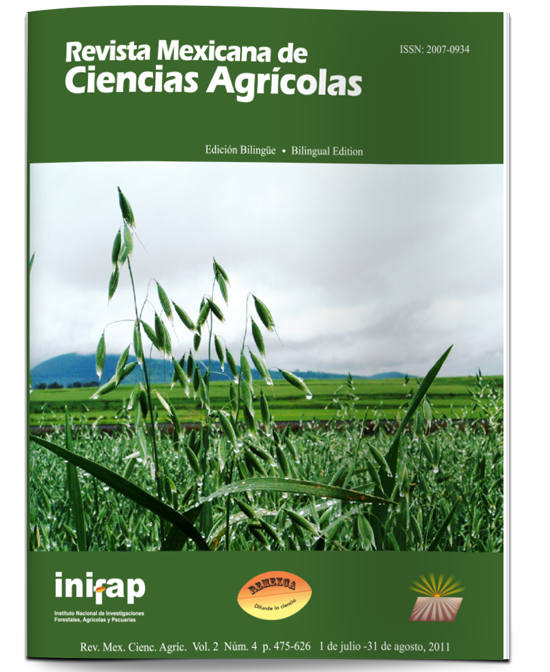H-70: HIGH YIELD MAIZE HYBRID FOR RAINFED AND IRRIGATED OF THE CENTRAL HIGHLANDS OF MEXICO
DOI:
https://doi.org/10.29312/remexca.v2i4.1651Keywords:
Zea mays L., semi-crystalline white grain, trilinear hybrid, intermediate type maturityAbstract
The genetic improvement of maize in Valles Altos, has allowed the development of hybrids with high yield, low bearing and resistance to lodging disease in the past decade; which have been products of the parent lines combination of VallesAltosof INIFAPandCIMMYT(Arellanoetal.,1997). H-70 resulted from that combination as a trilinear hybrid, with white grains and semi-crystalline texture, with favorable adaptation to elevations of 2 200 to 2 600 m, intermediate maturity, as it achieves male flowering or tasseling at 100 days and female or silking at 102 days, on average. Presents plant height of 2.4 m and cob height of 1.4 m. It is resistant to lodging disease and plant and cob diseases. Yield f luctuates from 4 to 13.3 t ha-1, under a density of 65 000 plants ha-1. The cob has an average length of 16 cm, with 18 rows and 34 grains per row. Cob weight is 180 g and the grain/cob ratio is 86%. The average weight of 100 grains is 43.3 g. Harvesting can be done at 180 days, with a grain moisture content of 25 to 26%, so the cob must undergo a drying process to reduce moisture down to 14%. If the producer does not have a dry storage, he can harvest at 210 days with a grain moisture content of 18% to 19% and continue with the natural cob drying. The yields obtained with H-70 exceeded in 13% the yield of commercial hybrids. The genetic constitution of this hybrid allows it to positively thrive at different rainfall levels and planting in areas with rainfall delay until May 15th. Its plant bearing provides intensive planting with 70 000 plants ha-1 for grain production and it has potential for forage production in irrigated areas and a good rainfall. The main economic impact of H-70 is the difference of 3 and 7 t ha-1 over the yield of native seeds, representing 7 to 14 thousand pesos per hectare. This increase makes profitable the maize production.
Downloads
Downloads
Published
How to Cite
Issue
Section
License
The authors who publish in Revista Mexicana de Ciencias Agrícolas accept the following conditions:
In accordance with copyright laws, Revista Mexicana de Ciencias Agrícolas recognizes and respects the authors’ moral right and ownership of property rights which will be transferred to the journal for dissemination in open access. Invariably, all the authors have to sign a letter of transfer of property rights and of originality of the article to Instituto Nacional de Investigaciones Forestales, Agrícolas y Pecuarias (INIFAP) [National Institute of Forestry, Agricultural and Livestock Research]. The author(s) must pay a fee for the reception of articles before proceeding to editorial review.
All the texts published by Revista Mexicana de Ciencias Agrícolas —with no exception— are distributed under a Creative Commons License Attribution-NonCommercial 4.0 International (CC BY-NC 4.0), which allows third parties to use the publication as long as the work’s authorship and its first publication in this journal are mentioned.
The author(s) can enter into independent and additional contractual agreements for the nonexclusive distribution of the version of the article published in Revista Mexicana de Ciencias Agrícolas (for example include it into an institutional repository or publish it in a book) as long as it is clearly and explicitly indicated that the work was published for the first time in Revista Mexicana de Ciencias Agrícolas.
For all the above, the authors shall send the Letter-transfer of Property Rights for the first publication duly filled in and signed by the author(s). This form must be sent as a PDF file to: revista_atm@yahoo.com.mx; cienciasagricola@inifap.gob.mx; remexca2017@gmail.
This work is licensed under a Creative Commons Attribution-Noncommercial 4.0 International license.



